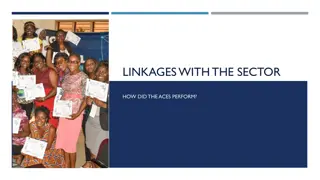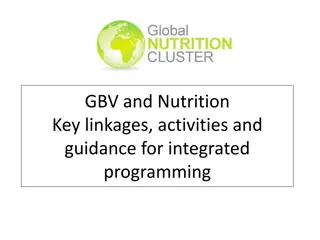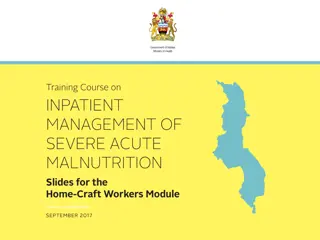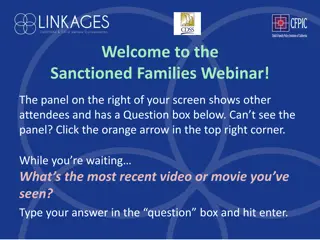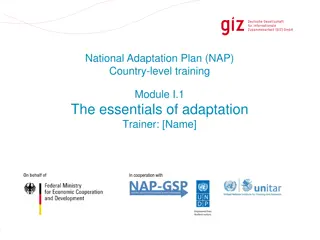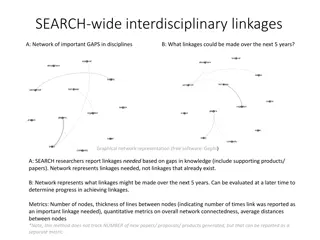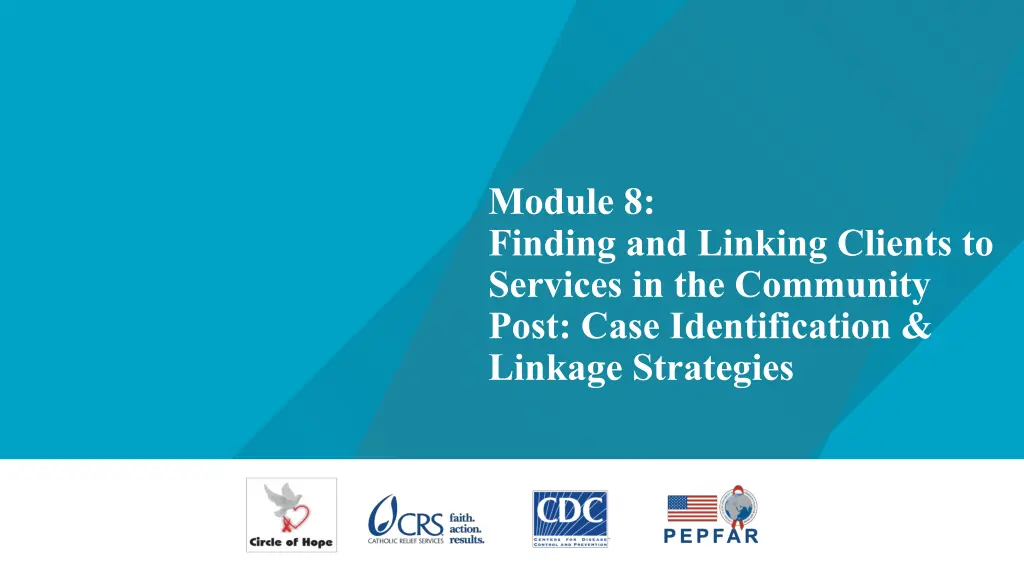
Improving HIV Service Uptake Through Community Engagement
Explore strategies and challenges in linking clients to essential HIV services within the community. Learn about case identification, linkage strategies, and the role of CP teams in promoting HIV testing. Discover how community posts can enhance service uptake and patient flow in the CP model.
Download Presentation

Please find below an Image/Link to download the presentation.
The content on the website is provided AS IS for your information and personal use only. It may not be sold, licensed, or shared on other websites without obtaining consent from the author. If you encounter any issues during the download, it is possible that the publisher has removed the file from their server.
You are allowed to download the files provided on this website for personal or commercial use, subject to the condition that they are used lawfully. All files are the property of their respective owners.
The content on the website is provided AS IS for your information and personal use only. It may not be sold, licensed, or shared on other websites without obtaining consent from the author.
E N D
Presentation Transcript
Module 8: Finding and Linking Clients to Services in the Community Post: Case Identification & Linkage Strategies
Module 8 Objectives Understand contextual challenges in achieving epidemic control Explain the strategies used within the CP model to identify high-risk individuals in greatest need of HIV testing services and promote HIV testing Describe the roles of CP teams, and faith and community leaders, in promoting and creating demand for HIV services in the CP model Demonstrate understanding of the Walk and Celebration strategies used within the CP model to link clients to services and support index testing Describe the patient flow in the CP, including referral from community to health facility / 2 / 2
Challenges in Achieving Epidemic Control Goals Zambia 2016 Progress Toward Pediatric 90-90-90 Ineffective case identification approaches (community door-to-door testing has low positivity yield) (laboratory ARV-adjusted data): (ZAMPHIA 2016) Progress in uptake of HIV testing services stalled during the COVID-19 pandemic Lower uptake of HIV testing among men, adolescents and young adults Insufficient testing of children of adults on ART Interruptions in treatment for the working population (focus on income generation activities vs. treatment) Interruption in treatment for mobile populations Source: ZAMPHIA Report 2019 / 4 / 4
How do Community Posts Increase Uptake of HIV Services? /5 /5
Creating Demand for CP Services: Quality Customer Care A Satisfied Client .. o Helps build the image, brand, and reputation of a facility and MOH o Is a natural repeat client o Is a compliant client o Progresses along the HIV treatment cascade/continuum of care 95-95-95 .....and is a healthy client! o Is best at marketing and advertising for others to see and experience o Can potentially attract funding and partnerships /6 /6
Creating Demand for CP Services: Mobilizing Faith & Community Leaders/Stakeholders Faith/Community Leader Trainings: deliver information/education on services, including HTS Ongoing relationship-building and mobilization of key influencers: promote HTS uptake among high-risk individuals Distribution of Information, Education and Communication & Social and Behavioral Change Communication materials Leverage health and non-health community meetings: Provide information, education, and services (e.g., HTS screening and testing) Attend meetings of faith communities (especially 'healing crusades'): screen and follow-up healing seekers /7 /7
Creating Demand for CP Services: CHW Sensitization and Mobilization in HIV Hotspots CHWs embed themselves in the day-to-day life of the community and understand what is happening in relation to the three 95s Establish/build relationships with community members and key influencers to identify individuals in greatest need of testing Some CHWs are expert clients who act as models to demonstrate the benefits of ART /8 /8
Creating Demand for CP Services: Reaching Men Community leader endorsement of CP instills trust in men Location of the Community Post is convenient for men Located in busy work settings where men work and socialize No additional costs to reach services as they are offered where men are Men spend very little time off their work to access the services Blended into its setting (market, bus stop area) CPs remove stigma attached to accessing a typical clinic Walk strategy and partner notification: As more women test for HIV than men, the women who test HIV+ become the index clients to reach their male partners /9 /9
Case Identification Everyone is involved in case identification: all members of the CP team (Team Leader to CHWs) and community stakeholders have a shared responsibility toidentify individuals for testing Case ID relies on building relationship and trust with clients and communities Capacity building of Community Post staff focuses heavily on building their emotional intelligence to support case ID Every person counts: Individual to be tested (and eventually put on treatment) come on board one at a time /10 /10
Case Identification: Provider Initiated Targeted Community Testing & Counselling Majority of testing occurs in the community CHWs utilize community knowledge, connections, and risk screening tools to identify individuals for testing Sensitivity and emotional intelligence Embedded in community/know networks and hotspots Enhanced probing skills/graceful persuasiveness CHWs and Psycho-Social Counsellors (PSS) are certified testers Following an initial positive test (in community), the individual is accompanied to the Community Post (Walk Strategy) for confirmatory test /11 /11
Adult (15+ years) HIV Risk Screening Tool /13 /13
Case Identification: Index Contact Testing & Assisted Partner Notification Biological Children (<19 Years) /15 /15
Elements of Successful Index Testing Overcoming personal stigma RECIPE Emotional intelligence Index profiling Elicited contacts profiling Accompaniment; the Walk Celebration (the welcome) /16 /16
Case Identification: Social Network Strategy (SNS) A recruitmentstrategy for reaching and providing HTS to persons who are unaware of their HIV infection by using social network connections to locate individuals at the highest risk for HIV Based on the notion that people may be more likely to accept testing when encouraged by someone within the same social network Enlist HIV-positive and high-risk, HIV- negative persons (recruiters) to identify individuals from their social, sexual, and drug-using networks (network members) for HTS /17 /17
The CP Model Walk Strategy Following positive test results in the community, CHWs or PSS Counselors personally walk clients back to CP for confirmatory test AND Same Day ART Initiation (SDART) or PrEP During walk (approx. 10-20 minutes), CHWs/PSS Counselor builds a relationship with the client by: Listen more, talk less (allow client to talk about anything and everything) Be aware of client s feelings and affirm those feelings Show empathy/offering holistic care (e.g., connecting on a human level) Support clients to manage personal stress Provide client-centered tailored services Gather info/index profiling on client attributes (e.g., male/female; type of dress; language; marital status; employment status and type of work) /18 /18
How Does the Walk Strategy Increase Client Continuity of Treatment? Enhances client s personal contact/trust with CHWs and ART providers Improves social support system Personal information gathered enables CP to tailor services (index testing) to the need of the individual client Contributes to improved client tracking as CP staff come to know/understand the client better Partner notification introduced at the right time /19 /19
How Does the Walk Strategy Support Index Testing? During Walk, CHW encourages client to take responsibility for their lives and the lives of others CHWs captures names/contact info of index case contacts by asking: Do you have any contacts (biological children (<19 years of age), sexual/injecting partners) that you care about? Wouldn t it be better if they are also placed on treatment? CHWs highlights benefits of HIV treatment Reduces the amount of HIV (i.e., viral load) in your blood Helps you stay healthy and prevent illness Reduces risk of HIV transmission to HIV-negative partners ('Undetectable = Untransmittable' (U=U) /20 /20
Celebration/Welcome Strategy Celebration/Welcome Strategy is designed to make client feel safe, assured, accepted, cared for and celebrated Upon arrival at CP, Team Leader and PSS Counsellor warmly welcomes client with a smile, handshake, and/or hug (if possible) Through signalling, the CHW gives indicates to the Team Leader/PSS Counsellor if they have asked the client question about sexual contacts If not, CP team decides who will inquire about client s sexual partners based on client profiling results /21 /21
Patient Flow /22 /22
Prioritizing core values and motivating CP teams are critical to the success of case identification and testing promotion! /23 /23


